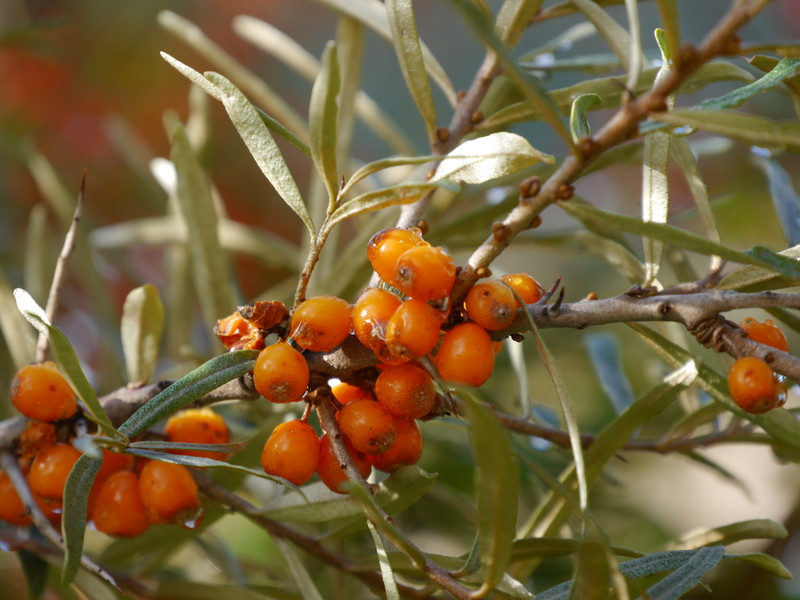Sea buckthorn
Elaeagnus rhamnoides (L.) A.Nelson
Eleagnaceae
This is a plant that you will not find in l’Herbier du Diois’ garden but in hedges that surround our buildings and our fields. These hedges constitute an important natural element of the site: they allow wildlife to coexist with the activities of the company, maintaining ecological connectivity with the surrounding natural spaces … much to the pleasure of our little frog living at the entrance of our offices!
This thorny shrub with its pretty silver foliage is found naturally in the mountains, in marl areas and along streams. It has an important ecological role, stabilizing soil and protecting it from erosion.
It is recognized by its small orange fruits that ripen from August to September and can persist further into autumn. Sea buckthorn is dioecious, which means that there are female plants and male plants, the latter of course bearing no fruit.
Despite its size, this tangy little fruit is a natural treasure, and even though the sharp spines ensure their protection, it should not discourage us from harvesting it. It is an exceptional source of vitamin C, 30 times more than oranges, but also of other vitamins, such as vitamin E and provitamin A (beta carotene). It also contains lycopene, a pigment that gives it the orange color and that is also found in tomatoes.
These nutrients make it a powerful antioxidant and a valuable help for winter time because sea buckthorn helps to strengthen the immune system.
Sea buckthorn has yet another treasure, more difficult to extract: its vegetable oil from the seeds and pulp of the fruit, which contains omega 3, 6, 9 and omega 7, unsaturated fatty acids, whose natural sources are very rare. These fatty acids have active skin regenerating properties and are highly valued allies for natural cosmetics. Sea buckthorn oil is used pure or in creams to relieve irritations, protect the skin from aggressions, treat chapped skin etc….
For cooking, it is a tasty but very acidic fruit, which explains why it is not easily consumed as it is, but rather processed. In the Alps where seabuckthorn can be abundant, many growers and gatherers make jams, fruit pastes or syrups with these fruits…
“pate de fruit” full of vitamins
Fabriquer des pâtes de fruits vitaminée
Presser des fruits d’argousier et placer dans une casserole 5 cl de jus avec 2 grammes d’agar agar
Diluer et faire chauffer une minute.Ajouter 5 cl de jus d’argousier et 6 cuillères à soupe de pulpe de fruit (framboise par exemple) et 2 cuillères à soupe de sucre
Mélanger et cuire une minute
Couler dans des moules ou dans un plat Le lendemain découper et laisser sécher un ou deux jours Rouler dans le sucre puis placer sur un papier sulfurisé et dans une boîte bien fermée.
Fruits can be frozen until they are processed. The agar agar makes it possible not to overcook the preparation and not to put too much sugar compared to a conventional fruit paste.
